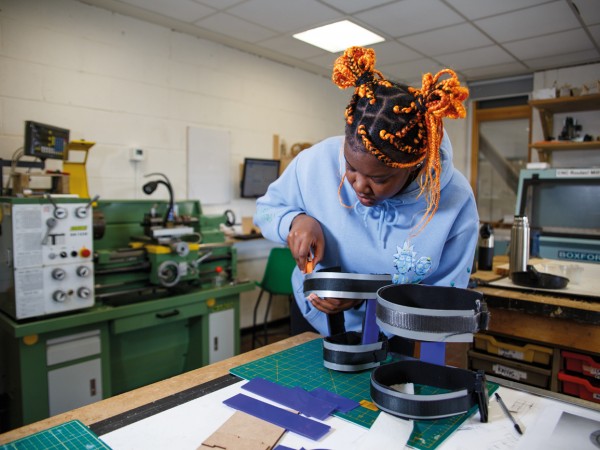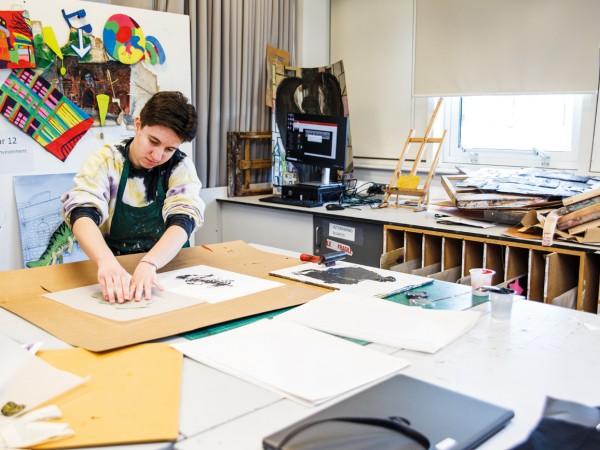Create, innovate, solve problems and shape our future with Product Design. Explore through iterative design, the world of aesthetic & ergonomic commercial products. Students study the principles of Product Design to design a product or building as a major coursework project.
In our modern and developing Design and Technology facilities, you'll apply technical skills to test and create 3D models of products through various design approaches including hand sketching, CAD and 3D model making including laser cutting and 3D printing.
Both Design Engineering and Product Design courses lead to the same qualification so cannot be taken together. Product Design is compatible with most other A-level courses, depending on your chosen career path. Due to coursework workload we would not advise you to do three creative/heavy coursework subjects. The exact combination can lead to different career options and can be discussed with staff at enrolment events. Some career paths such as engineering or architecture may also require Maths or Physics A-level.
Course Content
First Year
Students will explore the real world of design in its widest sense, through a range of tasks including design projects, theory lessons, Maths questions, some short practical tasks and 4 ½ hours home learning per week.
In year 12 opportunities will be given to practice crucial coursework skills including workload management, sketching and visual communication techniques, modelling, research skills, product analysis and creative. Knowledge will also be built on topics such as manufacturing processes theory, materials and their properties and relevant mathematical concepts. Students will apply these skills and knowledge through small projects, tasks and exam questions.
To enable students to develop the industry standard skills they need for visual communication and virtual testing students are expected to work through an additional CAD programme independently using instructive online tutorials.
The individual Product Design coursework (NEA) will begin in year 12, allowing students to choose an area of interest and investigate, create, test and refine the functionality of a chosen 3D product to solve a real life problem. Students are supported to become independent learners and will gain an understanding of, and simulate the work of professional designers in their project work by project managing their own coursework. This is a challenging activity including independent research visits and conducting interviews with specialists who can guide their project, as well as managing a high workload, but will reward students with confidence and life skills to take into the workplace or university in the future.
Second Year
The coursework is completed early in the second year then the focus is on exam revision.
First Year
Students will explore the real world of design in its widest sense, through a range of tasks including design projects, theory lessons, Maths questions, some short practical tasks and 4 ½ hours home learning per week.
In year 12 opportunities will be given to practice crucial coursework skills including workload management, sketching and visual communication techniques, modelling, research skills, product analysis and creative. Knowledge will also be built on topics such as manufacturing processes theory, materials and their properties and relevant mathematical concepts. Students will apply these skills and knowledge through small projects, tasks and exam questions.
To enable students to develop the industry standard skills they need for visual communication and virtual testing students are expected to work through an additional CAD programme independently using instructive online tutorials.
The individual Product Design coursework (NEA) will begin in year 12, allowing students to choose an area of interest and investigate, create, test and refine the functionality of a chosen 3D product to solve a real life problem. Students are supported to become independent learners and will gain an understanding of, and simulate the work of professional designers in their project work by project managing their own coursework. This is a challenging activity including independent research visits and conducting interviews with specialists who can guide their project, as well as managing a high workload, but will reward students with confidence and life skills to take into the workplace or university in the future.
Second Year
The coursework is completed early in the second year then the focus is on exam revision.
Methods of Teaching, Learning and Assessment
The Product Design A-level course combines teaching methodologies such as, collaborative small group discussions and design critiques, whole class questions and answer activities, exam questions and some hands-on project-based learning, to encourage students to actively engage with real-world design and develop their problem-solving skills. Students must also engage in independent reading, Maths, CAD and project work between lessons. Regular feedback is provided in a variety of ways and small group support is available where necessary.
Methods of Assessment
The OCR final assessment is through one large iterative design project and two written examinations. There is a Maths content in the examined unit equalling 25% of the grade. This is at higher tier GCSE Maths level and will be taught as part of the theory content for the course.
Unit 1
Principles of Product Design
Exam
26.7%
Unit 2
Problem Solving
Exam
23.3%
Unit 3
Iterative Design Project
Coursework
50%
The Product Design A-level course combines teaching methodologies such as, collaborative small group discussions and design critiques, whole class questions and answer activities, exam questions and some hands-on project-based learning, to encourage students to actively engage with real-world design and develop their problem-solving skills. Students must also engage in independent reading, Maths, CAD and project work between lessons. Regular feedback is provided in a variety of ways and small group support is available where necessary.
Methods of Assessment
The OCR final assessment is through one large iterative design project and two written examinations. There is a Maths content in the examined unit equalling 25% of the grade. This is at higher tier GCSE Maths level and will be taught as part of the theory content for the course.
|
Unit 1 |
Principles of Product Design |
Exam |
26.7% |
|
Unit 2 |
Problem Solving |
Exam |
23.3% |
|
Unit 3 |
Iterative Design Project |
Coursework |
50% |
Progression
Students will have access to careers in interior design, automotive design, model making, product design, computer aided design and architecture, this may be through apprenticeships or university.
Students will have access to careers in interior design, automotive design, model making, product design, computer aided design and architecture, this may be through apprenticeships or university.
Resources
Design and Technology has a purpose built suite of rooms complete with a CAD room, design studio and small workshop including a range of industry standard CNC machines and 3D printers.
Design and Technology has a purpose built suite of rooms complete with a CAD room, design studio and small workshop including a range of industry standard CNC machines and 3D printers.
Equipment and Charges
Equipment
Students must also provide the following:
- Scientific calculator (not on a phone)
- A4 lever arch ring bound folder & 10 tab dividers
- A4 lined pad or exercise book for notes
- Pen
- Sketching Pencil , Rubber , 30cm Ruler , Protractor
- Pritt stick
- Sellotape
- A pair of basic headphones that can plug into the PC
- A squared exercise book
- Your own copy of the D&T My Revision Notes book
- Your own copy of the Essential Maths Skills book
- Optional Studio Kit
Charges
Access to a PC at home will be a huge advantage as you will be able to download CAD software and work on coursework more easily. Students will also be required to pay around £10 per year towards materials for their coursework project and home access to 3D modelling software. Students must provide the equipment below including buying two books at a cost of approx. £35. The cost of all trips will be the responsibility of the student.
Financial assistance is available if required through the student bursary scheme, this should be applied for as soon as possible.
Equipment
Students must also provide the following:
- Scientific calculator (not on a phone)
- A4 lever arch ring bound folder & 10 tab dividers
- A4 lined pad or exercise book for notes
- Pen
- Sketching Pencil , Rubber , 30cm Ruler , Protractor
- Pritt stick
- Sellotape
- A pair of basic headphones that can plug into the PC
- A squared exercise book
- Your own copy of the D&T My Revision Notes book
- Your own copy of the Essential Maths Skills book
- Optional Studio Kit
Charges
Access to a PC at home will be a huge advantage as you will be able to download CAD software and work on coursework more easily. Students will also be required to pay around £10 per year towards materials for their coursework project and home access to 3D modelling software. Students must provide the equipment below including buying two books at a cost of approx. £35. The cost of all trips will be the responsibility of the student.
Financial assistance is available if required through the student bursary scheme, this should be applied for as soon as possible.
Enrichment
Visits may include the Design Museum or V&A in London. We also encourage students to make contact with industry experts to support their coursework.
Visits may include the Design Museum or V&A in London. We also encourage students to make contact with industry experts to support their coursework.
Where can this course lead?
Product Design has been added to My Courses
Loading...


